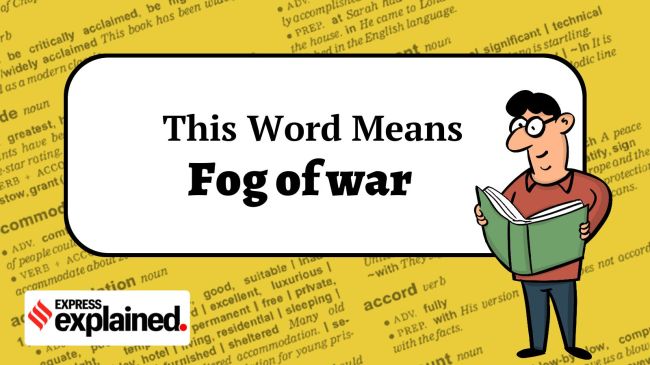Opinion This word means: Fog of war
Every day, 500 words on a word (or expression) that has appeared in The Indian Express.
 The phrase is used to describe the “complexity of military conflicts” and the difficulties in finding out accurate information pertaining to it.
The phrase is used to describe the “complexity of military conflicts” and the difficulties in finding out accurate information pertaining to it. WHY NOW?
 As tensions flare up between India and Pakistan, analysts and observers have increasingly invoked the phrase “fog of war” to describe the confusion and chaos surrounding recent developments.
As tensions flare up between India and Pakistan, analysts and observers have increasingly invoked the phrase “fog of war” to describe the confusion and chaos surrounding recent developments.It has also been used to describe the widespread mis/disinformation on social media platforms and even some sections of the media.
WHAT IS ‘FOG OF WAR’?
According to the Oxford Dictionary of Phrases and Fables (2005), the phrase is used to describe the “complexity of military conflicts”.
It attributes the phrase to Carl von Clausewitz, a military general and war theorist in the kingdom of Prussia (comprising modern-day Germany and other parts of Central Europe). It is believed to be a paraphrased version of what he wrote in his book On War (1832): “War is the realm of uncertainty; three quarters of the factors on which action in war is based are wrapped in a fog of greater or lesser uncertainty.”
Clausewitz introduced the concept of “friction” to describe the physical and psychological obstacles that complicate warfare — an idea that later evolved into what we now call the “fog of war”.
The exact phrase was first used in 1896 by Lonsdale Augustus Hale, a British Colonel, to describe the “state of ignorance” among commanders over ground realities, including the strength and position of foes and allies. The phrase was subsequently adopted by the US armed forces to refer to operational challenges that could impair the decision-making capabilities of leaders, including but not limited to information warfare and intelligence gaps.
AND WHAT IS THE RELAVANCE OF ‘FOG OF WAR’ NOW?
Analysts have used the phrase to refer to the broader uncertainty around the current round of India-Pakistan tensions — including how and when they will subside.
Tensions rose in the aftermath of the April 22 Pahalgam attack, where terrorists gunned down 26 civilians. India responded with targeted strikes on the intervening night of May 6 and 7, which struck nine terror camps in Pakistan and Pakistan-occupied Kashmir (PoK).
Pakistan then retaliated with an escalation in ceasefire violations along the Line of Control (LoC) and air strikes in the northern and western frontiers of India. On Thursday, the Ministry of Defence stated that it had neutralised the air defence system in Lahore in response to Pakistani aggression. Later in the night, Indian forces thwarted a swarm of Pakistani drones and missiles that targeted military establishments in border states.
ZOOMING OUT: THE THREAT OF MIS/DISINFORMATION
As tensions escalate, so does the battle of optics. Experts have repeatedly warned against mis/disinformation circulating online.
Multiple social media handles have been sharing and amplifying unsubstantiated claims, including AI-generated videos, misleading captions on re-purposed old videos and images, and fake news. The Press Information Bureau’s (PIB’s) fact-check unit has been flagging unverified claims, such as the closure of ATMs and a ban on entry to all Indian airports.
Given the lack of information amid the chaos of attacks and retaliation, it is impossible for detectors to flag each of these false claims, much less the general public.
Significantly, the government has also invoked its legal powers to block content that it finds to be propagating misinformation. Social media handles of several Pakistani news sites have been blocked in India. Meanwhile, Elon Musk-owned X stated that it was complying — reluctantly — with a government order to remove 8,000 accounts, including some international news organisations and accounts with a large number of followers.






